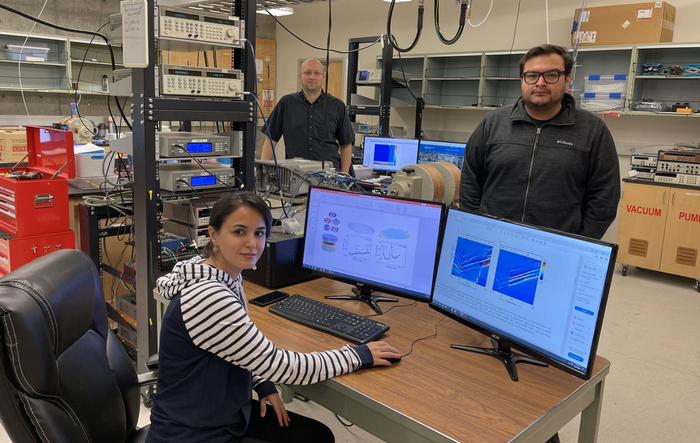A comprehensive manual for engineering spin dynamics in nanomagnets has been developed by an international research group at the University of California, Riverside, and the Institute of Magnetism in Kyiv, Ukraine.
 Arezoo Etesamirad (Seated) And Rodolfo Rodriguez (Right) Are Seen Here with Igor Barsukov. Image Credit: Barsukov lab, UC Riverside.
Arezoo Etesamirad (Seated) And Rodolfo Rodriguez (Right) Are Seen Here with Igor Barsukov. Image Credit: Barsukov lab, UC Riverside.
It is a significant step taken toward advancing spintronic and quantum-information technologies.
Despite their small size, nanomagnets—discovered in most spintronic applications—disclose rich dynamics of spin excitations, or “magnons,” the quantum-mechanical units of spin fluctuations.
As a result of its nanoscale confinement, a nanomagnet could be considered to be a zero-dimensional system with a distinct magnon spectrum, similar to the spectrum of an atom.
The magnons interact with each other, thus constituting nonlinear spin dynamics. Nonlinear spin dynamics is a major challenge and a major opportunity for improving the performance of spintronic technologies such as spin-torque memory, oscillators, and neuromorphic computing.
Igor Barsukov, Study Corresponding Author and Assistant Professor, Physics and Astronomy, University of California-Riverside
The study has been reported in the journal Physical Review Applied.
Barsukov described that the interaction of magnons tracks a set of rules—the selection rules. Currently, scientists have postulated such rules concerning symmetries of magnon profiles and magnetization configurations.
The new work retains the measures to tame nanomagnets for next-generation computation technologies. In an earlier publication, the team illustrated experimentally that symmetries could be utilized for engineering magnon interactions.
We recognized the opportunity, but also noticed that much work needed to be done to understand and formulate the selection rules.
Igor Barsukov, Study Corresponding Author and Assistant Professor of Physics and Astronomy, University of California-Riverside
Scientists feel that an extensive set of rules displays the mechanisms behind the magnon interaction.
It can be seen as a guide for spintronics labs for debugging and designing nanomagnet devices. It lays the foundation for developing an experimental toolset for tunable magnetic neurons, switchable oscillators, energy-efficient memory, and quantum-magnonic and other next-generation nanomagnetic applications.
Arezoo Etesamirad, Study First Author, University of California-Riverside
Etesamirad is the first author of the study who collaborated in the Barsukov laboratory and recently graduated with a doctoral degree in physics.
Barsukov and Etesamirad were made as a part of the research performed by Rodolfo Rodriguez of UCR; and Julia Kharlan and Roman Verba of the Institute of Magnetism in Kyiv, Ukraine.
The study was financially supported by the US National Science Foundation, National Academy of Sciences of Ukraine, National Research Foundation of Ukraine, National Science Center – Poland, and NVIDIA Corporation.
Journal Reference:
Etesamirad, A., et al. (2023) Controlling Selection Rules for Magnon Scattering in Nanomagnets by Spatial Symmetry Breaking. Physical Review Applied. doi.org/10.1103/PhysRevApplied.19.044087.